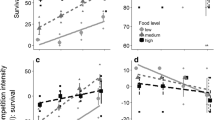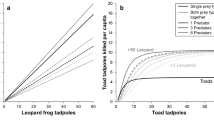Summary
Tadpoles of the tree frog, Hyla chrysoscelis, were raised at low and high levels of two independent, growth-limiting resources: solid food substrates and ingestible particles. The effect of resource level on intraspecific competition was measured as the relative importance of interference versus exploitative competitive mechanisms. The levels of both solid food substrates and particles affected the outcome of competition among the tadpoles, despite their independent effects on growth. Current models of competition generally allow only one resource to limit population growth. This result implies that more than one resource may influence the outcome of intraspecific competition.
Similar content being viewed by others
References
Akin GC (1966) Self-inhibition of growth in Rana pipiens tadpoles. Physiol Zool 39:341–356
Leon JA, Tumpson DB (1975) Competition between two species for two complementary or substitutable resources. J Theor Biol 50:185–201
Licht LE (1967) Growth inhibition in crowded tadpoles: intraspecific and interspecific effects. Ecology 48:736–745
Morrison DF (1967) Multivariate statistical methods. McGraw-Hill, New York
Rapport DJ (1971) An optimization model of food selection. Am Nat 105:575–587
Richards CM (1958) The inhibition of growth in crowded Rana pipiens tadpoles. Physiol Zool 31:138–151
Richards CM (1962) The control of tadpole growth by alga-like cells. Physiol Zool 35:285–296
Rose SM (1960) A feedback mechanism of growth control in tadpoles. Ecology 41:188–198
Sokal RR, Rohlf FJ (1969) Biometry. San Francisco: WH Freeman and Co
Steinwascher K (1978) Interference and exploitation competition among tadpoles of Rana utricularia. Ecology 59:1039–1046
Steinwascher K (1979a) Host-parasite interaction as a potential population-regulating mechanism. Ecology 60:884–890
Steinwascher K (1979b) Competitive interactions among tadpoles: Responses to resource level. Ecology 60:1172–1183
West LB (1960) The nature of growth inhibitory material from crowded Rana pipiens tadpoles. Physiol Zool 33:232–239
Fienberg SE (1970) The analysis of multidimensional contingency tables. Ecology 51:419–433
Goodman LA (1971) The analysis of multidimensional contingency tables: Stepwise procedures and direct estimation methods for building models for multiple classifications. Technometrics 13:33–61
Author information
Authors and Affiliations
Rights and permissions
About this article
Cite this article
Steinwascher, K. Competition for two resources. Oecologia 49, 415–418 (1981). https://doi.org/10.1007/BF00347609
Received:
Issue Date:
DOI: https://doi.org/10.1007/BF00347609




